For many dog lovers, the joy of pet ownership can be overshadowed by persistent allergies. Sneezing, itching, and watery eyes are common reactions to pet dander, a primary trigger for dog allergies. This often leads people to seek out “hypoallergenic” dog breeds, which are commonly understood to shed less and therefore distribute fewer allergens into the environment. If you’re looking for the ideal companion that won’t leave you constantly reaching for tissues, understanding which breeds are genuinely low-shedding is key to finding your perfect furry friend. Discovering the right breed can open up a world of companionship, allowing you to enjoy all the love and loyalty a dog offers without the constant allergic reactions. Whether you’re a first-time dog owner or looking to add to your family, selecting one of the best dog breeds that doesn’t shed can significantly improve your quality of life. Among the many choices available, some breeds are particularly noted for their minimal shedding coats and adorable personalities, making them popular choices for families, including those interested in cute dog breeds.
Understanding “Hypoallergenic” Dogs: What Does “Non-Shedding” Really Mean?
The term “hypoallergenic” is often misunderstood when it comes to dogs. While many breeds are marketed this way, it’s crucial to understand that no dog is 100% allergen-free. All dogs produce allergens, primarily from proteins found in their skin (dander), saliva, and urine. What makes certain breeds “hypoallergenic” is their tendency to shed very little hair. Less shedding means less dander, which is attached to the hair, is released into the environment. This reduction in airborne allergens can significantly decrease allergic reactions for many individuals.
Even breeds known for being low-shedding still have dander and produce saliva and urine, all of which contain allergens. For severely allergic individuals, even minimal exposure can trigger symptoms like coughing, itching, wheezing, or skin rashes. However, for people with mild to moderate dog allergies, a low-shedding breed can make a substantial difference, enabling them to live comfortably with a canine companion. Managing allergies effectively also involves regular grooming and maintaining a clean home environment, as discussed later in this guide.
Top Dog Breeds That Don’t Shed (or Shed Minimally)
Here’s a comprehensive look at some of the best dog breeds that don’t shed, making them excellent choices for individuals and families dealing with dog allergies.
1. Poodle
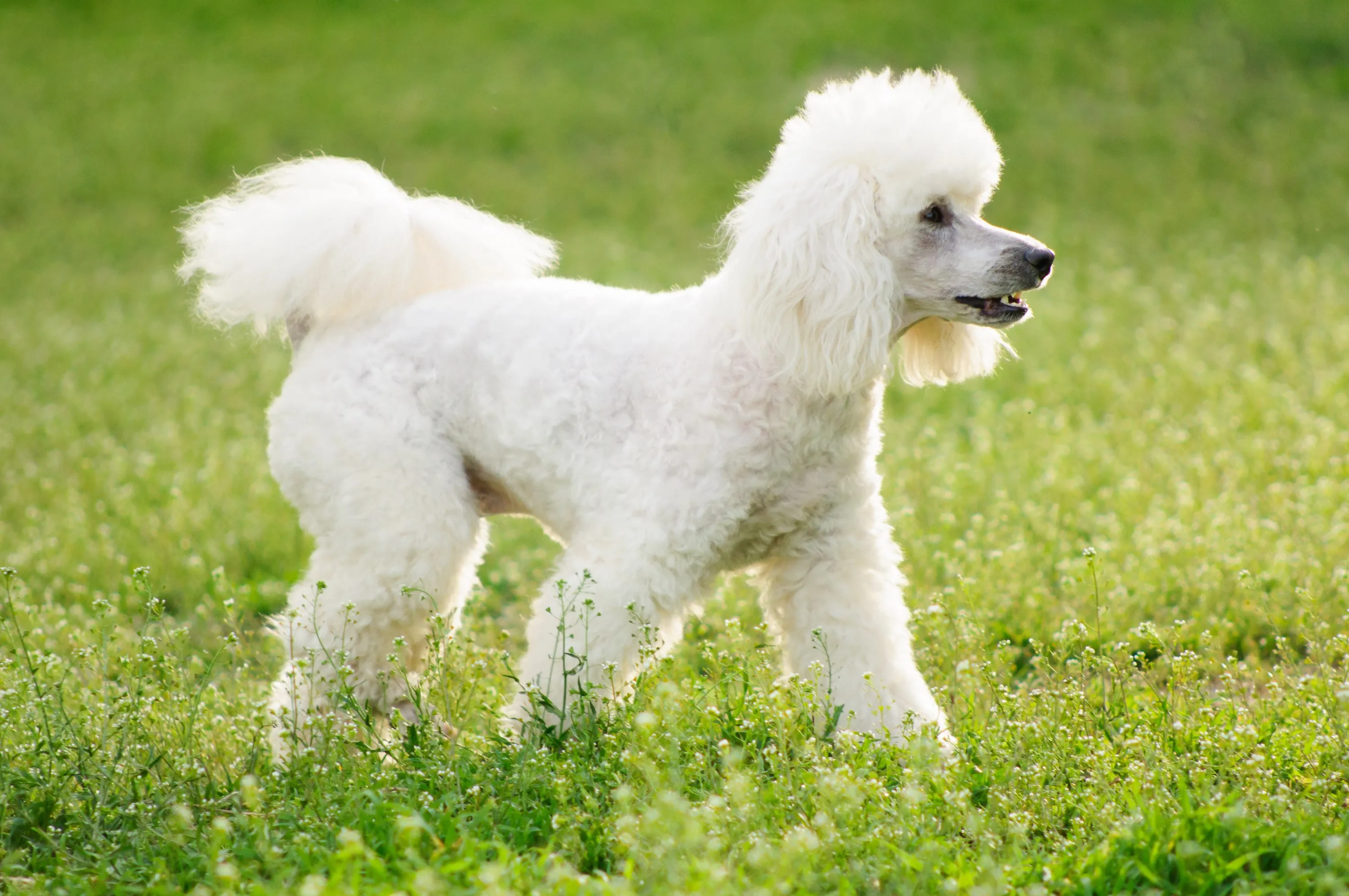 White Poodle walking through green grass
White Poodle walking through green grass
Poodles are perhaps the most well-known “hypoallergenic” breed, famous for their distinctive curly coats that shed minimally. There are three main varieties: Standard, Miniature, and Toy Poodles, all sharing the same low-shedding quality. Beyond their elegant appearance, Poodles are highly intelligent, easily trainable, and possess a playful yet dignified temperament. The Standard Poodle was originally bred as a water retriever, showcasing their athleticism and intelligence. Miniature and Toy Poodles were developed to be smaller companions. Despite their low shedding, Poodles require regular grooming, including brushing and professional clipping every 4-6 weeks, to prevent their dense, curly fur from matting. Their active nature means they also need consistent exercise and mental stimulation to thrive.
2. Yorkshire Terrier
 Blue and tan Yorkshire Terrier relaxing on an armchair
Blue and tan Yorkshire Terrier relaxing on an armchair
Yorkshire Terriers, often affectionately called Yorkies, are small dogs with big personalities. Their silky, fine hair is more akin to human hair than typical dog fur, which means they shed very little dander. Yorkies are known for being spirited, affectionate, and courageous companions. They adapt well to various living situations, from apartments to larger homes, as long as they receive ample attention and moderate exercise. Despite their small size, they require regular grooming to keep their long coats tangle-free and healthy. Daily brushing is often necessary, and many owners opt for a shorter “puppy cut” to simplify maintenance.
3. Shih Tzu
 Brown and white Shih Tzu lying on a living room floor
Brown and white Shih Tzu lying on a living room floor
The Shih Tzu is an ancient companion breed renowned for its luxurious, flowing double coat and friendly, outgoing disposition. While their long hair might seem like a shedding nightmare, Shih Tzus actually shed very little dander. They are charming, affectionate, and enjoy being close to their human families. However, their distinctive flat faces can predispose them to certain health concerns, such as breathing difficulties in hot weather and potential tear staining around their eyes, which requires regular cleaning. Their long coats need consistent daily brushing to prevent mats and tangles, along with professional grooming every few weeks.
4. Miniature Schnauzer
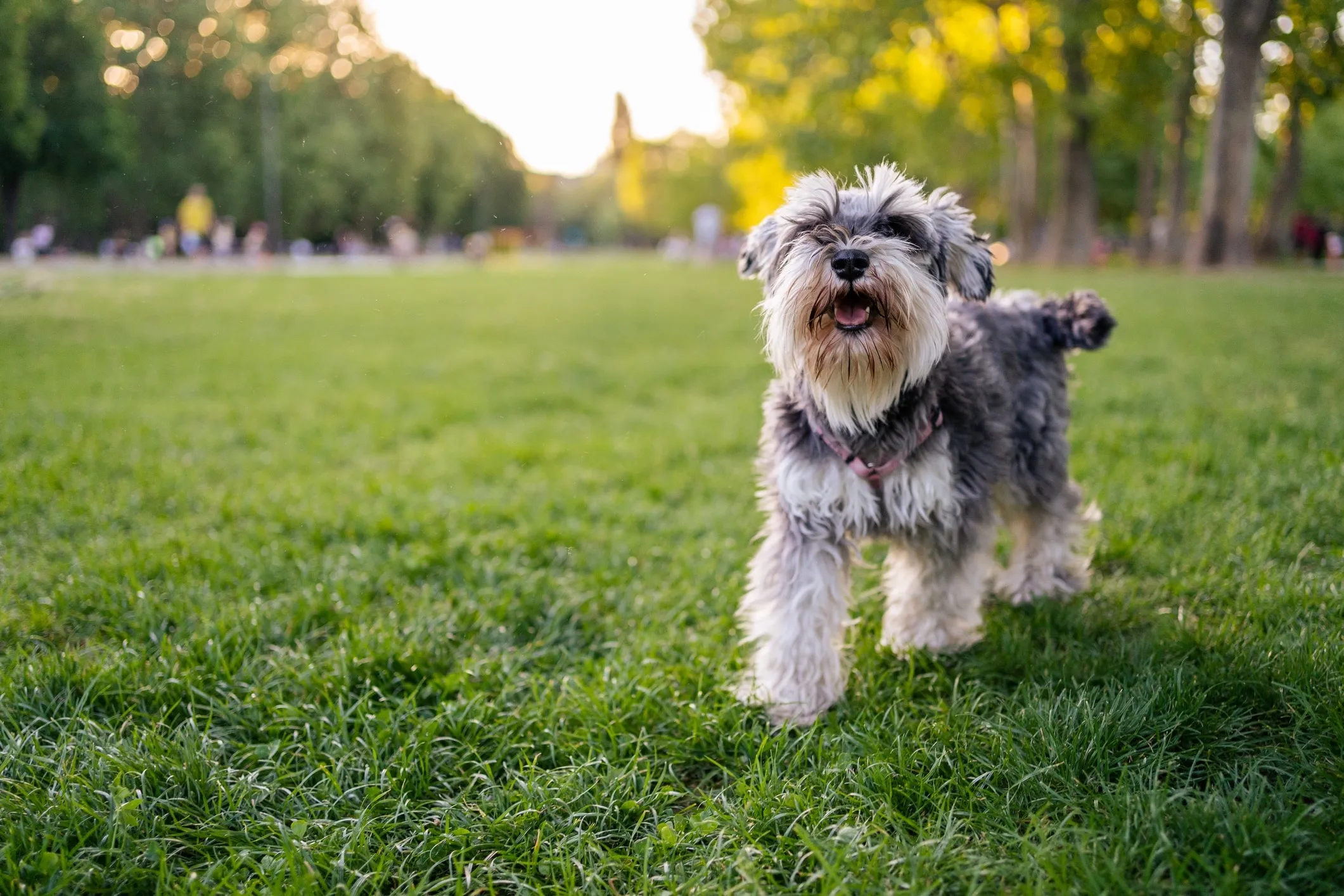 Salt and pepper Miniature Schnauzer wearing a pink harness in a park
Salt and pepper Miniature Schnauzer wearing a pink harness in a park
Miniature Schnauzers are robust, intelligent, and spirited dogs. Their wiry topcoat and soft undercoat shed minimally, making them a popular choice for allergy sufferers. Standing typically no more than 14 inches tall, they are versatile dogs that can thrive in various home environments, provided they receive sufficient physical and mental exercise. They are known for their alert nature, making them excellent watchdogs. Grooming for a Miniature Schnauzer involves regular brushing to prevent matting and professional hand-stripping or clipping to maintain their distinct appearance and coat texture.
5. Standard Schnauzer
 Gray Standard Schnauzer standing in a field
Gray Standard Schnauzer standing in a field
The Standard Schnauzer is the original Schnauzer breed, larger than its miniature counterpart but sharing the same low-shedding, wiry coat. These dogs are highly intelligent, playful, and require significant exercise and mental stimulation. They are protective and loyal, making great family pets for active households. Standard Schnauzers typically weigh up to 45 pounds and excel in dog sports and activities that challenge both their bodies and minds. Like the Miniature Schnauzer, their coats require regular grooming, including brushing and professional maintenance, to keep them in top condition.
6. Giant Schnauzer
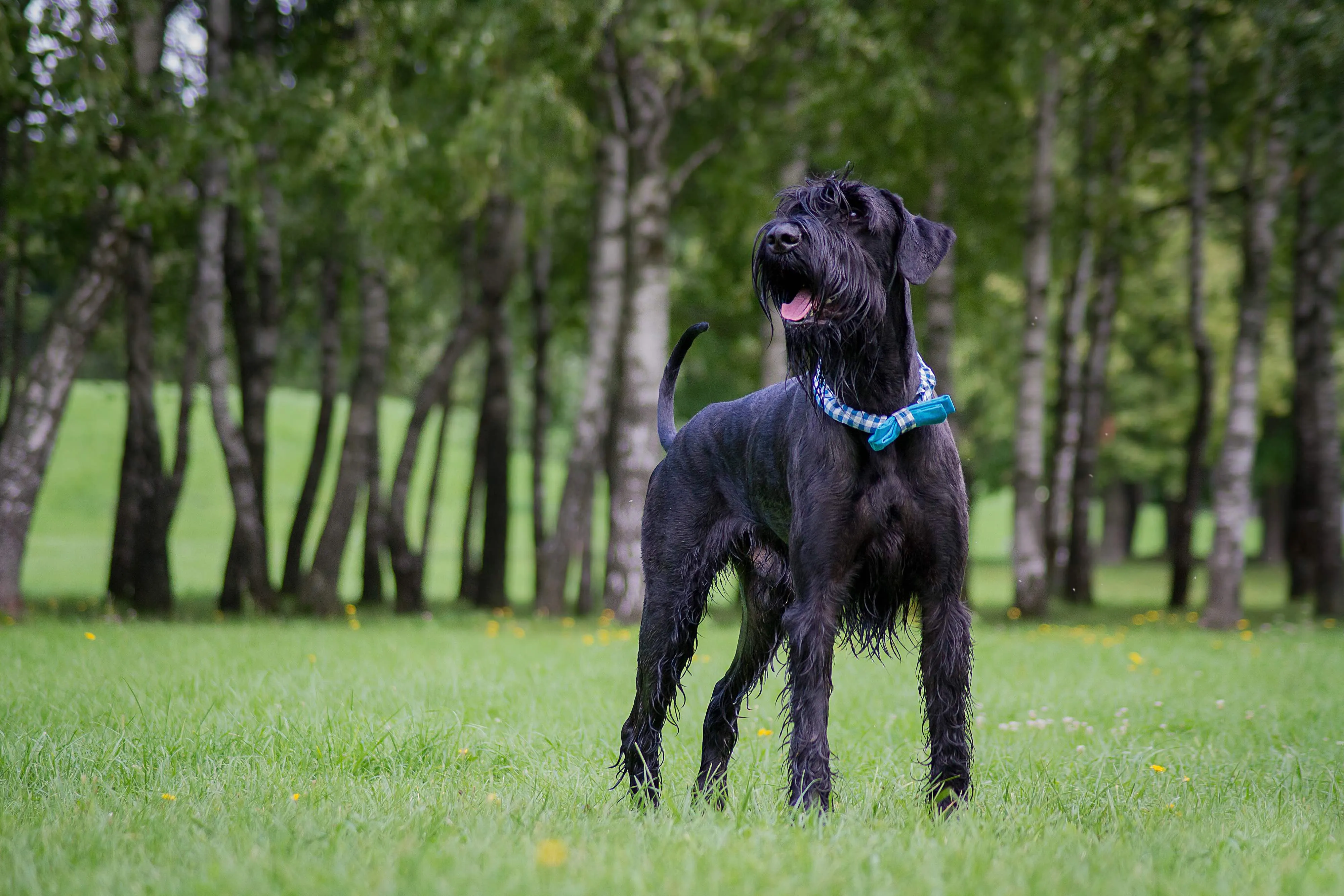 Black wet Giant Schnauzer wearing a blue bow collar standing in a park
Black wet Giant Schnauzer wearing a blue bow collar standing in a park
As the largest of the Schnauzer family, Giant Schnauzers are imposing yet equally low-shedding. Reaching over 27 inches tall and weighing up to 85 pounds, these powerful dogs need a dedicated owner who can provide extensive exercise and training. They are highly intelligent and protective, forming strong bonds with their families. Giant Schnauzers require rigorous exercise routines, such as long runs, hikes, and engaging play sessions, to prevent boredom and destructive behaviors. Their coarse, dense coat also demands regular brushing and professional grooming to stay healthy and mat-free.
7. Bichon Frise
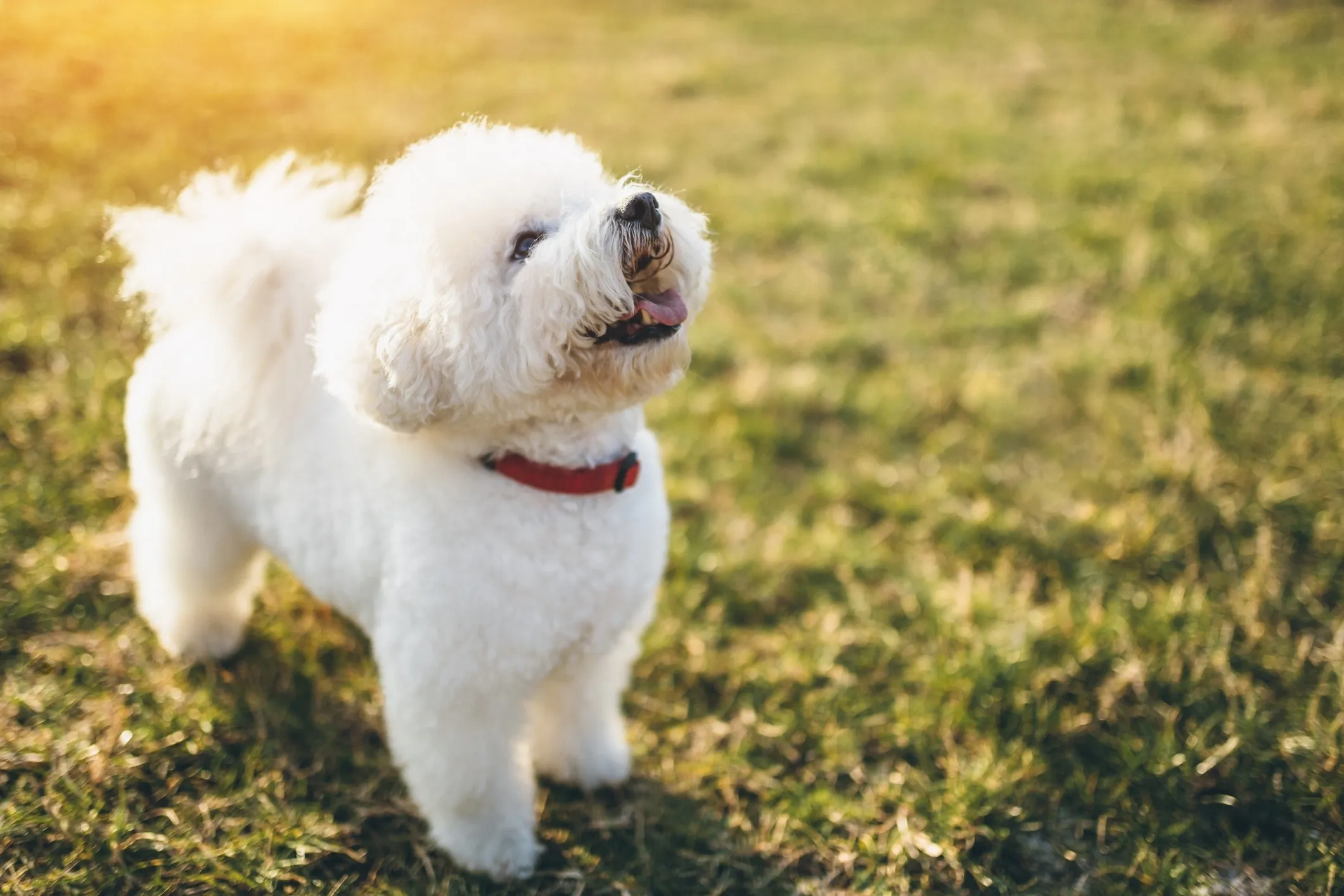 White Bichon Frise dog looking up in the grass
White Bichon Frise dog looking up in the grass
The Bichon Frise is a cheerful, playful, and affectionate little dog with a distinctive curly, powder-puff coat that sheds minimally. These charming pups are highly intelligent and eager to please, making them relatively easy to train with positive reinforcement. Bichons thrive on companionship and are known for their happy-go-lucky temperament, making them wonderful family pets. Their beautiful white coats require consistent daily brushing to prevent matting and professional grooming every 4-6 weeks to maintain their iconic look.
8. Chinese Crested
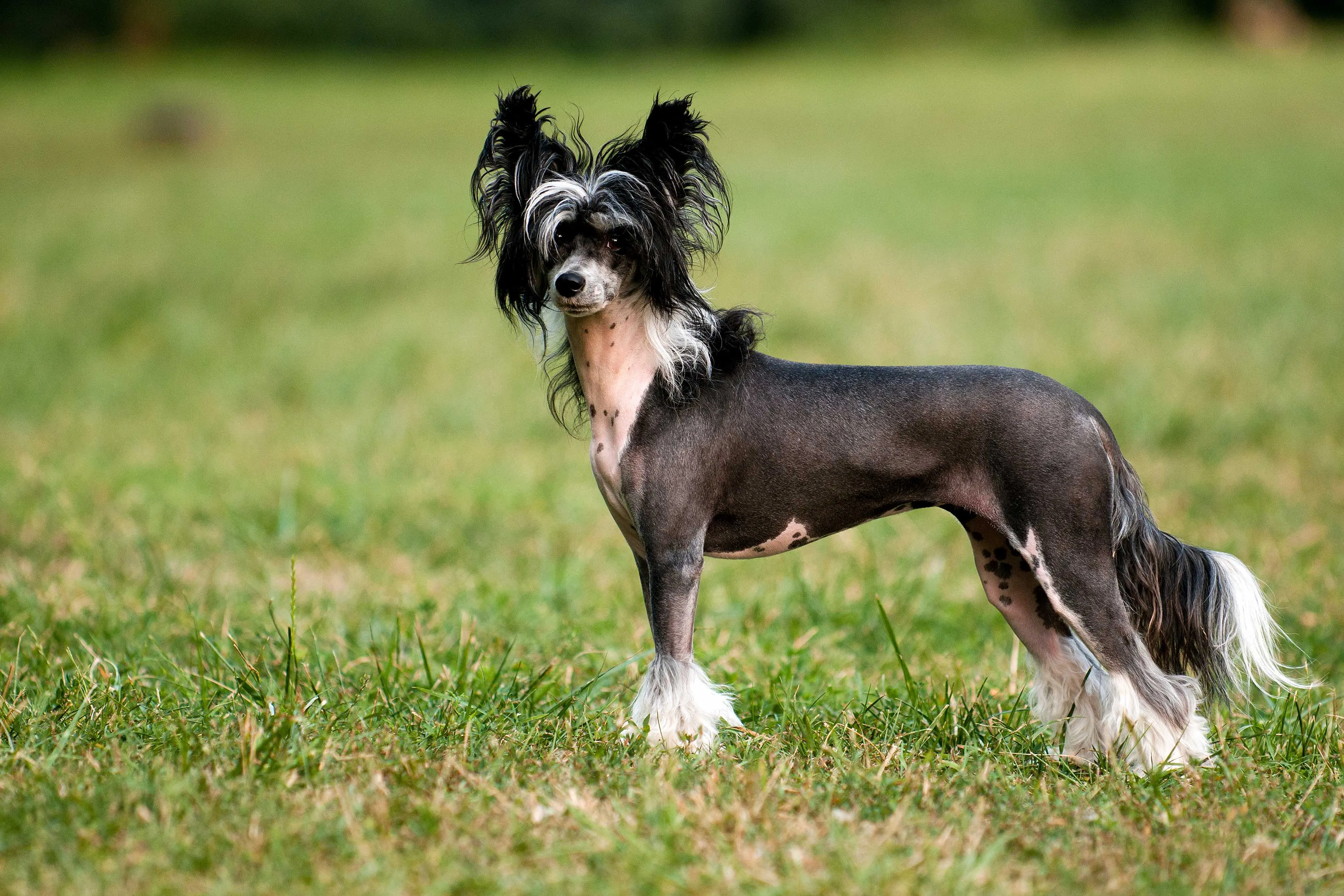 Black hairless Chinese Crested looking at the camera
Black hairless Chinese Crested looking at the camera
The Chinese Crested is a unique and distinctive breed, offering two varieties: hairless and powderpuff, both considered hypoallergenic. The hairless variety has soft, smooth skin with tufts of hair on its head, tail, and paws, making it ideal for those sensitive to dander. The powderpuff variety is covered in a full, silky coat that sheds very little. These small dogs are known for being playful, affectionate, and devoted companions. Both varieties require specific care: hairless Cresteds need skin protection from sun and cold, while powderpuffs need regular brushing to maintain their coat.
9. Portuguese Water Dog
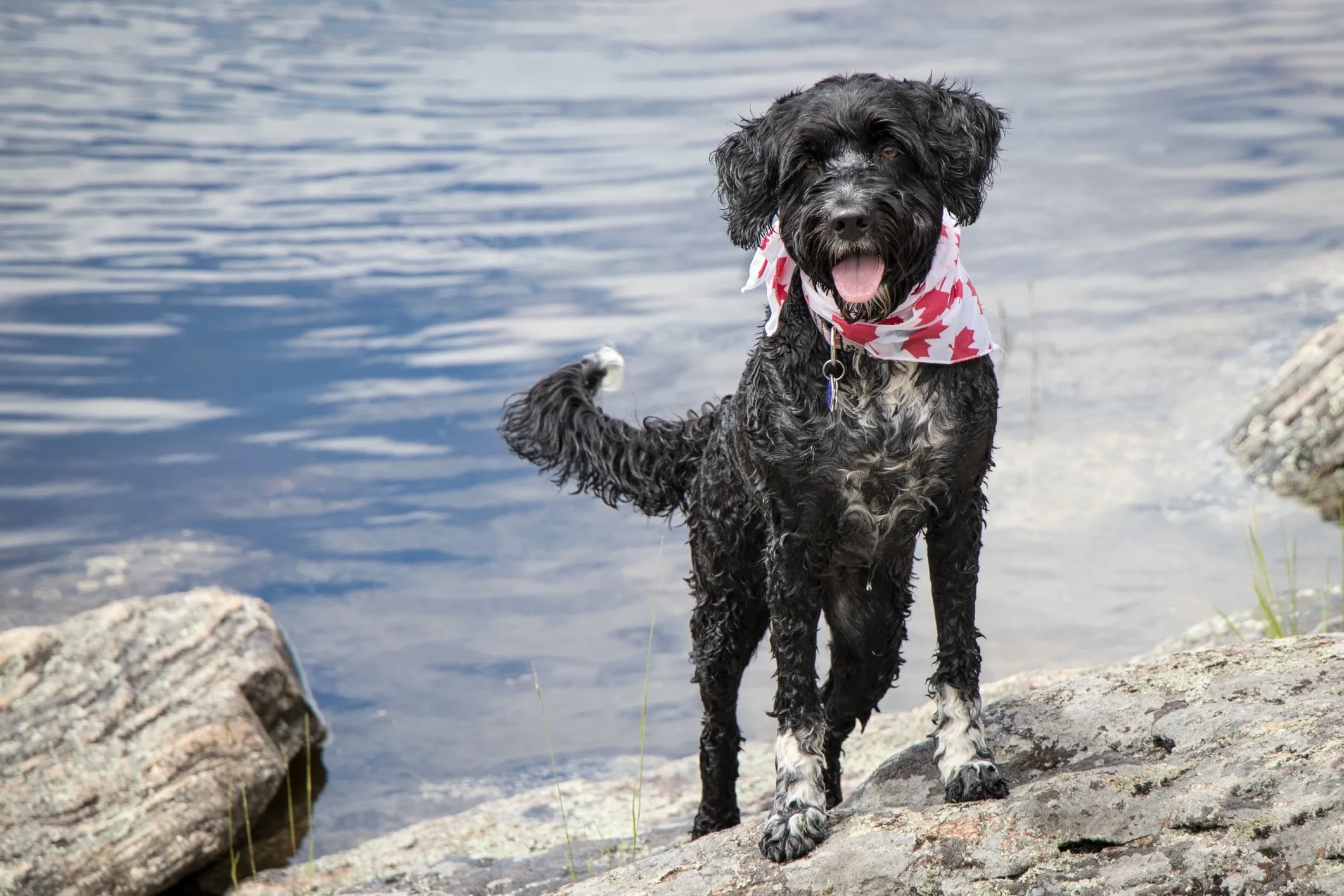 Black and white Portuguese Water Dog wearing a red maple leaf bandana in front of water
Black and white Portuguese Water Dog wearing a red maple leaf bandana in front of water
Originally bred to assist fishermen, the Portuguese Water Dog is a robust, intelligent, medium-sized breed with a dense, curly coat that sheds minimally. These dogs are highly energetic, intelligent, and eager to please, making them highly trainable and excellent companions for active families. They thrive on regular, vigorous exercise, especially activities involving water, which they naturally love. Their thick coats require consistent grooming, including regular brushing and clipping, to prevent matting and keep them healthy.
10. Labradoodle
 Brown standard Labradoodle walking in a park
Brown standard Labradoodle walking in a park
A crossbreed between a Labrador Retriever and a Poodle, the Labradoodle was originally developed to be a hypoallergenic service dog. They inherit the Poodle’s low-shedding coat and the friendly, intelligent nature of both parent breeds, making them exceptional family pets. Labradoodles are highly trainable, gentle, and adaptable, especially when properly socialized and exercised from an early age. Their coats can vary from wavy to curly and require regular brushing and grooming to prevent tangles and mats.
11. Goldendoodle
 Goldendoodle lying on a couch with a person sitting in the background
Goldendoodle lying on a couch with a person sitting in the background
Another popular “doodle” breed, the Goldendoodle is a mix of a Golden Retriever and a Poodle. Like Labradoodles, they are known for their low-shedding coats, friendly nature, and high intelligence. Goldendoodles are affectionate, playful, and make wonderful family companions. While often recognized for their golden coats, they come in a variety of colors and coat textures, from wavy to curly. Frequent grooming with a slicker brush is essential to prevent matting and keep their coats healthy.
12. Lagotto Romagnolo
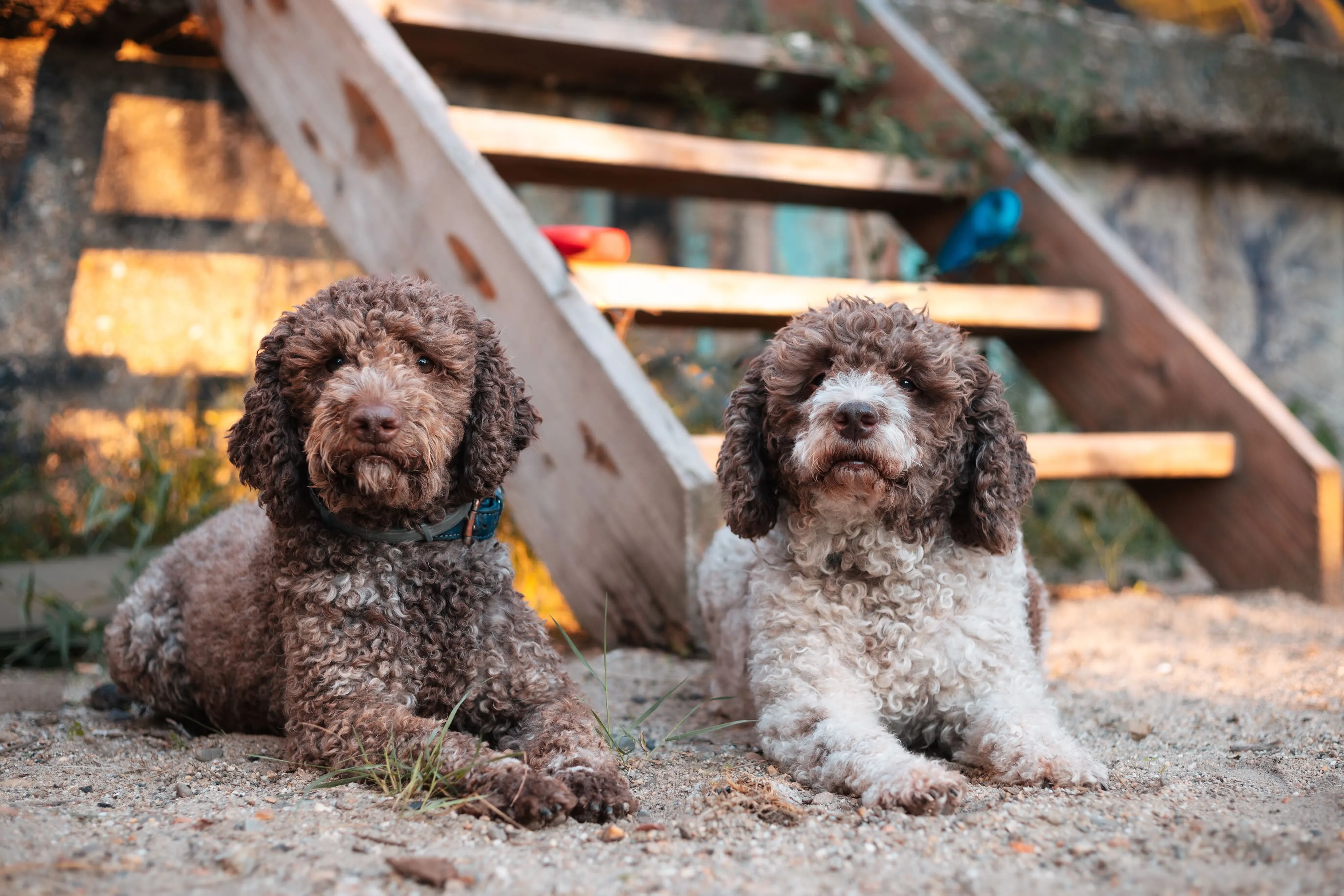 Two Lagotto Romagnolo dogs lying in dirt staring at the camera
Two Lagotto Romagnolo dogs lying in dirt staring at the camera
The Lagotto Romagnolo is an ancient Italian breed originally used as water retrievers and truffle hunters. Their dense, curly, woolly coat is low-shedding and provides excellent protection from cold water. While less common than some other hypoallergenic breeds, Lagotti Romagnoli are known for being affectionate, intelligent, and generally good with children and other pets, making them excellent family dogs. Their unique coats require regular grooming to prevent felting and matting.
13. Affenpinscher
 Black Affenpinscher dog close-up
Black Affenpinscher dog close-up
Affenpinschers are small, charming dogs known for their distinctive monkey-like expressions. Their dense, wiry coats shed minimally, contributing to their hypoallergenic qualities. These brave and curious dogs are intelligent and playful, often described as having a mischievous sense of humor. Despite their small size, their wiry coats require regular care, including brushing and occasional hand-stripping, a grooming technique where dead hairs are pulled out by the root, to maintain coat texture and reduce shedding.
14. Irish Water Spaniel
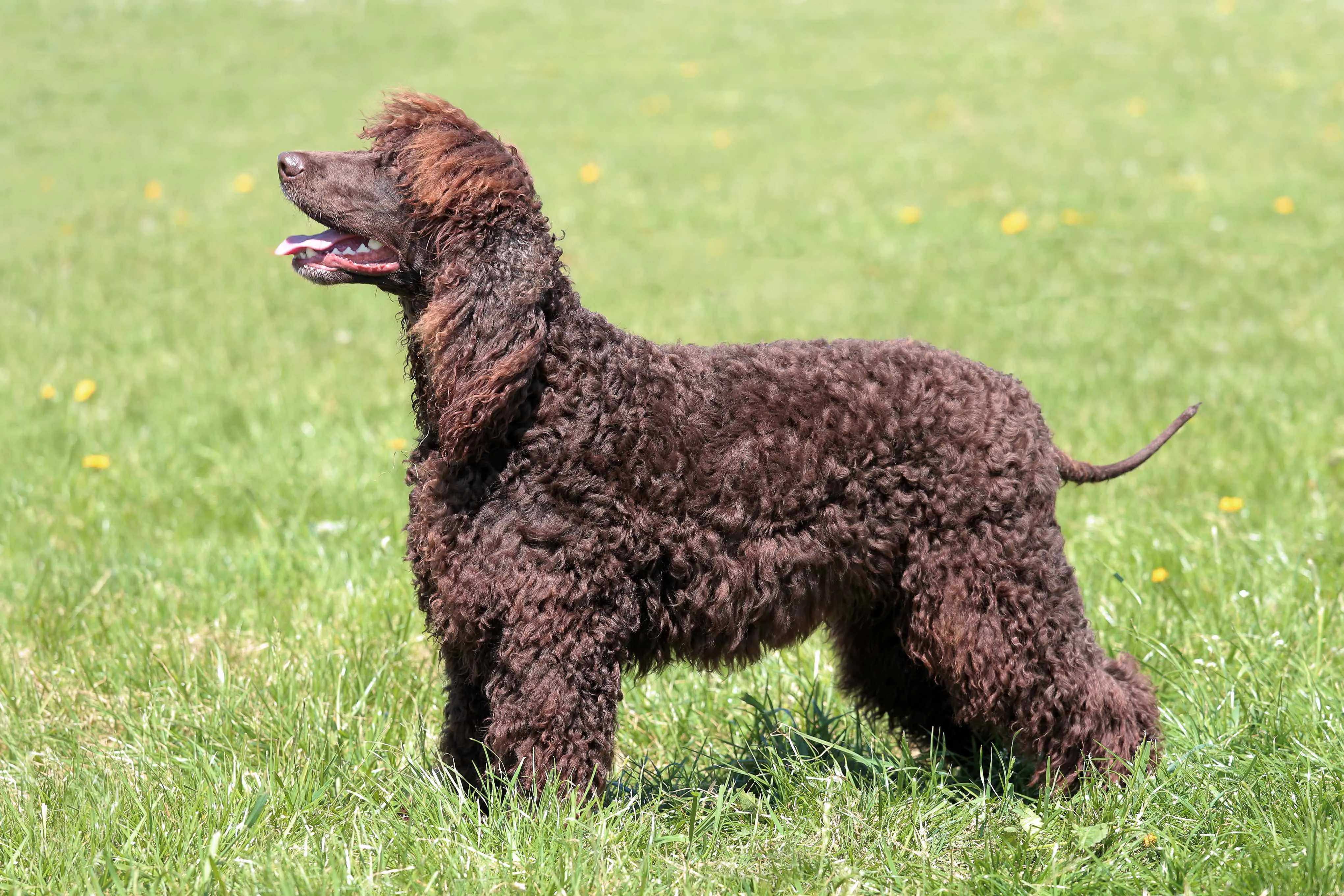 Brown Irish Water Spaniel profile
Brown Irish Water Spaniel profile
The Irish Water Spaniel is a distinguished and energetic breed, recognized by its tight, crisp curls and rat tail. As their name suggests, they are natural water dogs, originally bred for retrieving game. Their thick, liver-colored coat sheds minimally, but requires regular grooming to prevent matting. These friendly, intelligent, and highly trainable dogs possess a high energy level and need ample exercise to stay happy and healthy. They excel in dog sports and activities that allow them to use their natural retrieving instincts and love for water.
15. Aussiedoodle
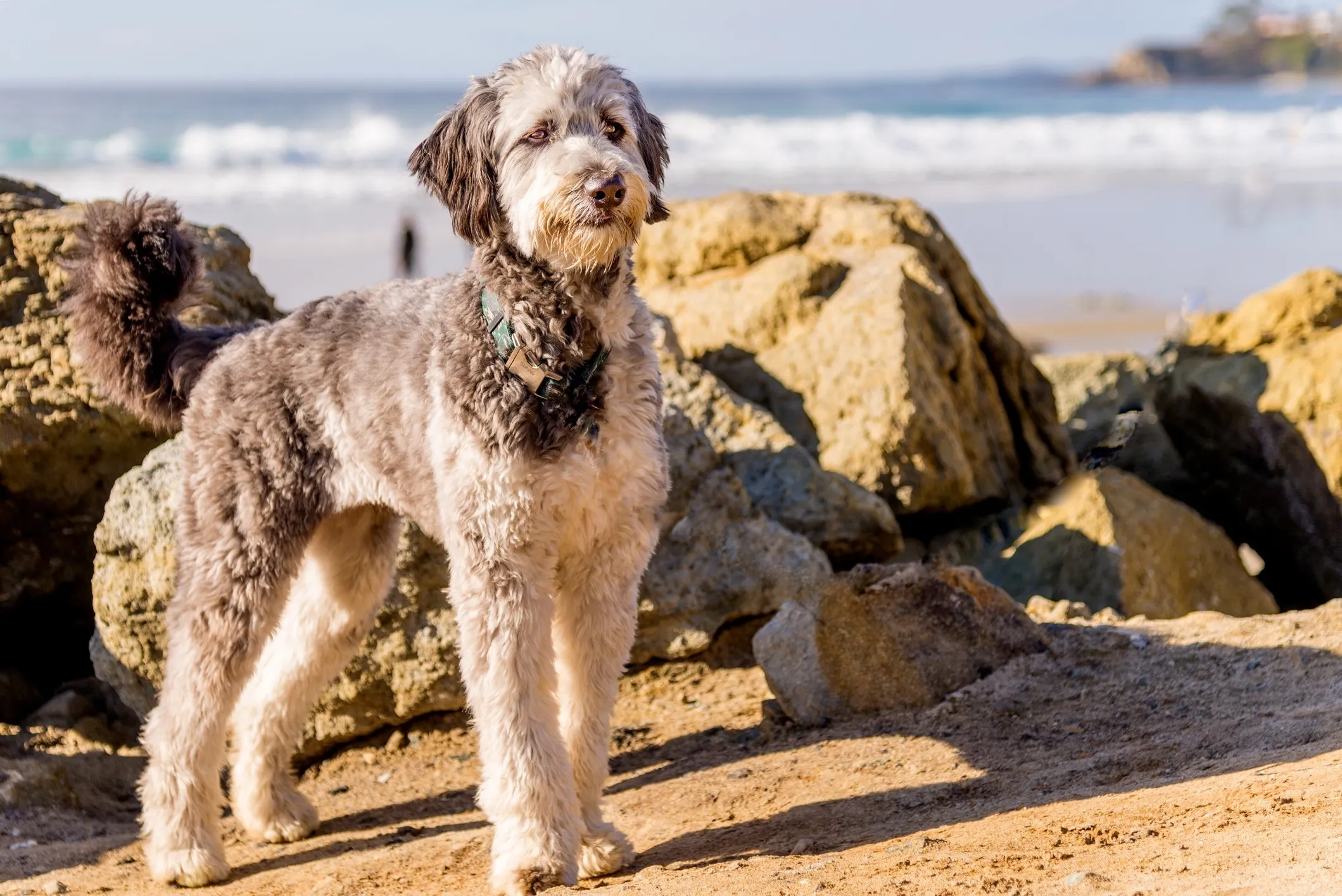 Standard Aussiedoodle dog standing on a beach
Standard Aussiedoodle dog standing on a beach
An Aussiedoodle is a cross between an Australian Shepherd and a Standard or Miniature Poodle, combining the intelligence and energy of both parent breeds with the Poodle’s low-shedding coat. These dogs are highly intelligent, eager to please, and very energetic, making them ideal for active families. They require significant mental and physical stimulation; without it, they can become bored and destructive. Regular exercise, training, and enrichment toys are essential to keep an Aussiedoodle happy and well-behaved. Their coats also need consistent brushing to prevent matting.
16. Bolognese
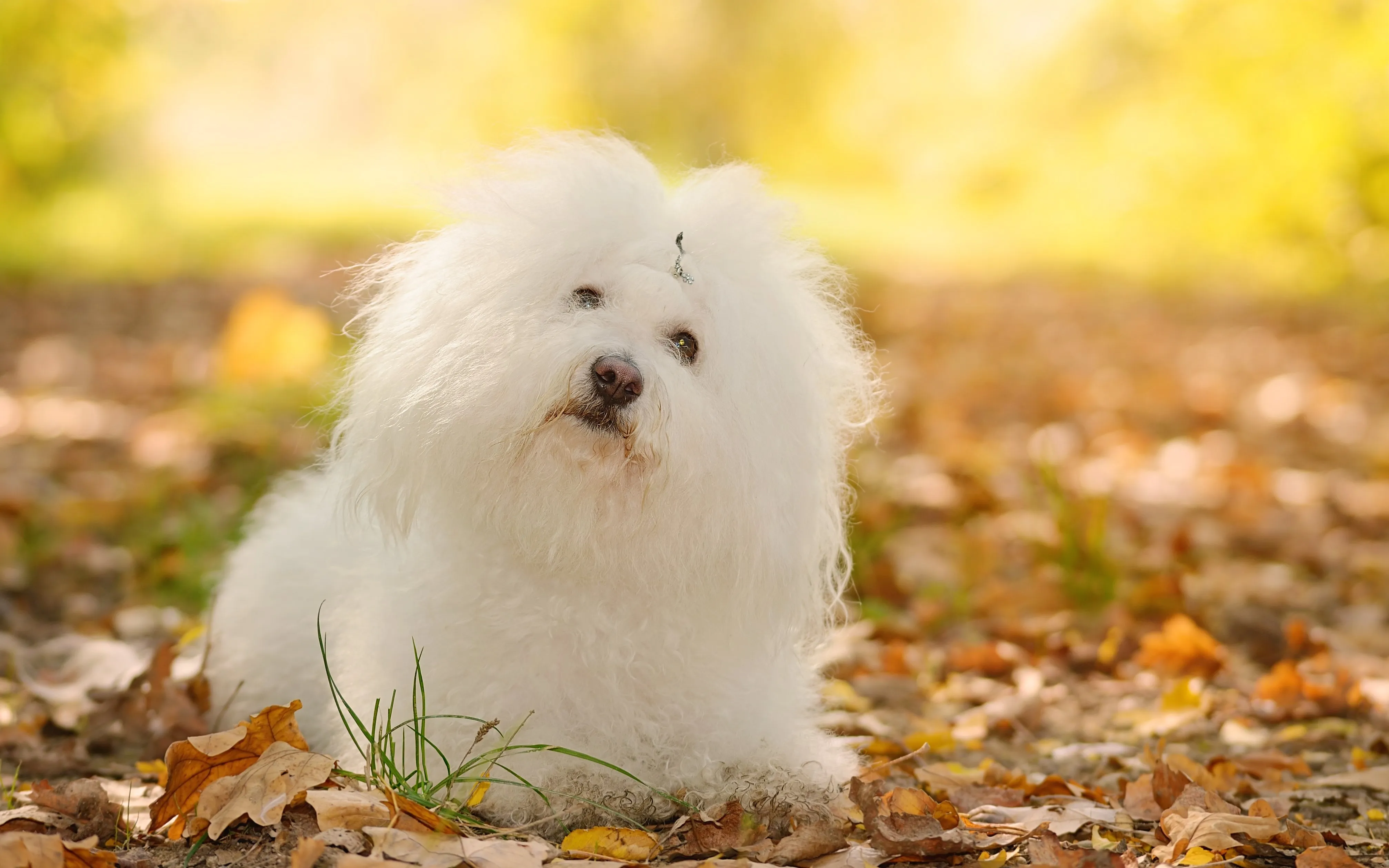 White Bolognese dog sitting in an autumn forest
White Bolognese dog sitting in an autumn forest
The Bolognese is a small, charming dog with a distinctive long, fluffy white coat that, despite its appearance, sheds minimally. Originating from Italy, these playful and easygoing pups are known for their affectionate nature and generally get along well with children and other pets. They are adaptable and can thrive in various living situations, from apartments to larger homes. While their coat is beautiful, it requires dedicated grooming, including daily brushing, to prevent mats and maintain its characteristic messy yet elegant look.
17. Maltese
 Woman holding a white Maltese dog on a bed
Woman holding a white Maltese dog on a bed
Maltese are elegant, small dogs famous for their luxurious, floor-length white coats that shed very little. They are affectionate, playful, and intelligent companions who thrive on human interaction. While their long coats are beautiful, they demand significant grooming to prevent tangles and mats. Many Maltese owners opt for a shorter “puppy cut” to simplify daily care. Regular brushing and professional grooming appointments are crucial to keep their coats pristine and free from skin issues.
18. Soft Coated Wheaten Terrier
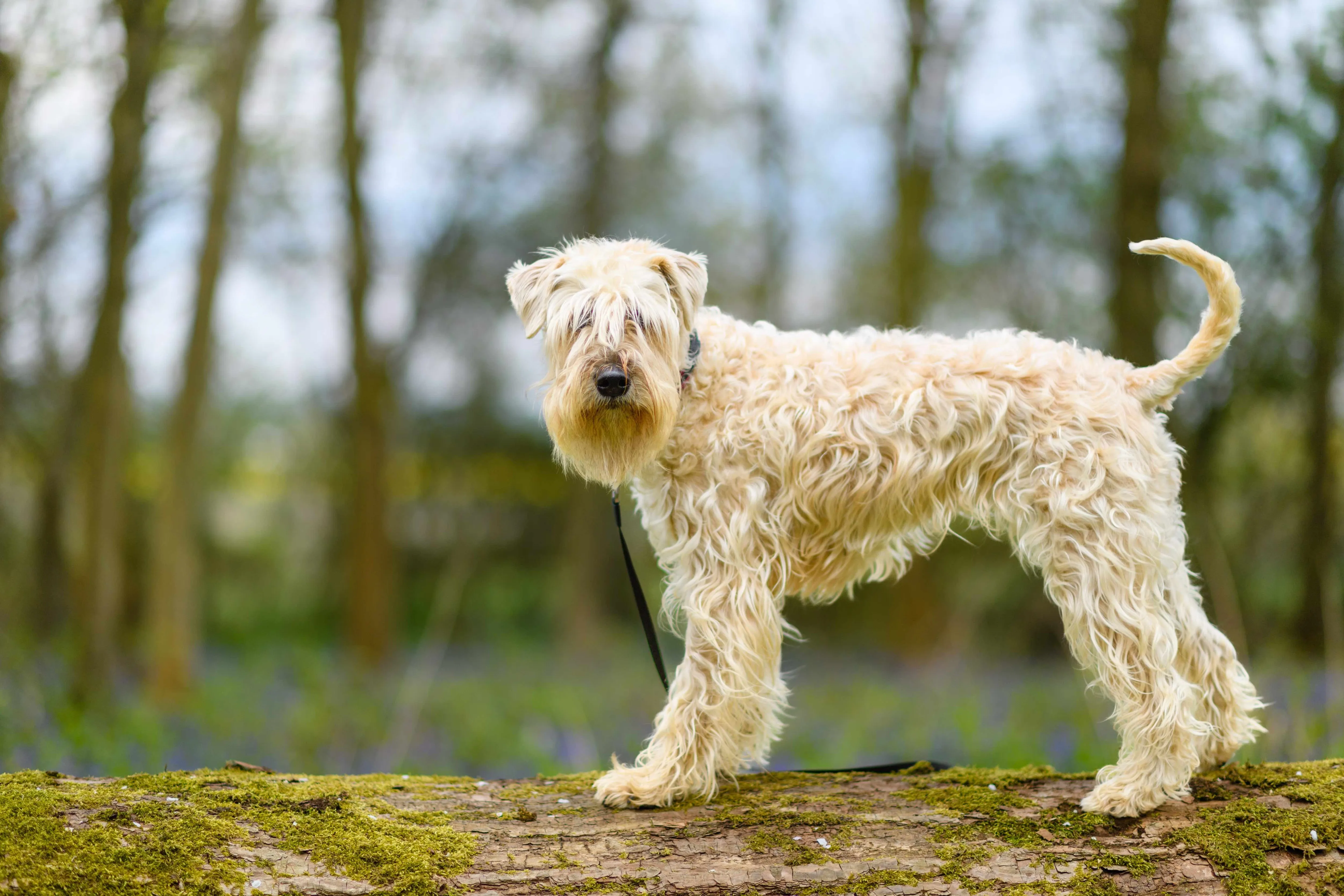 Soft Coated Wheaten Terrier dog on a log
Soft Coated Wheaten Terrier dog on a log
As their name suggests, the Soft Coated Wheaten Terrier possesses a silky, soft coat that feels like wheat. This medium-sized Irish breed is known for its minimal shedding, making it a good choice for allergy sufferers. Wheatens are joyful, intelligent, and energetic dogs that retain a puppy-like exuberance throughout their lives. They require ample exercise and mental stimulation to be well-behaved and happy. Their unique coat needs regular brushing to prevent mats and maintain its characteristic soft texture.
19. Coton de Tulear
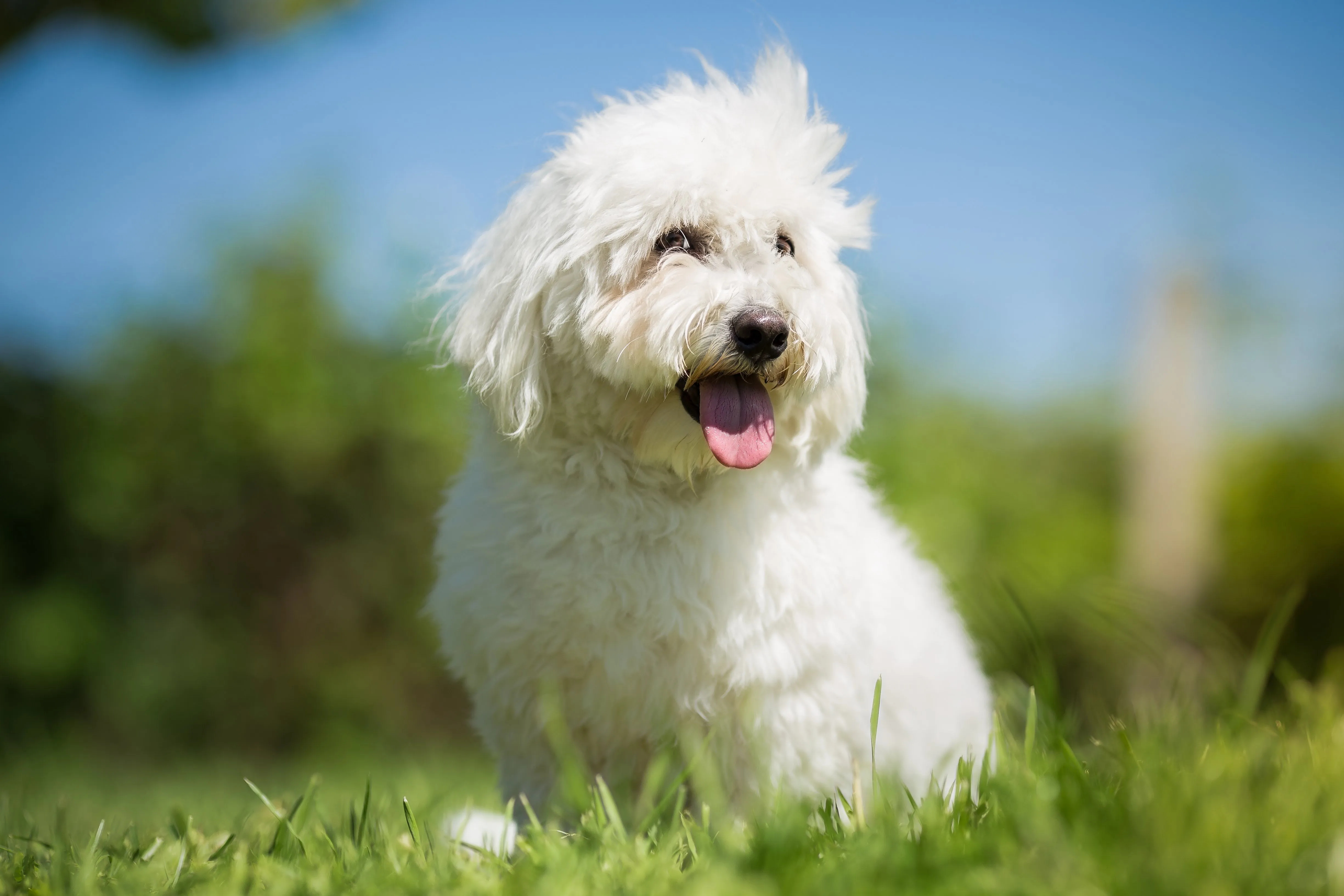 White Coton de Tulear sitting in grass with hair blowing in the wind
White Coton de Tulear sitting in grass with hair blowing in the wind
Originating from Madagascar, the Coton de Tulear is a small, charming breed with a distinctive cotton-like coat that sheds minimally. These easygoing and affectionate pups are known for their gentle nature, making them excellent companions for families with children and other pets, provided proper introductions are made. Cotons are playful and intelligent, enjoying both active play and quiet cuddle time. Their unique coat requires consistent brushing to prevent matting and keep it light and airy.
20. Schnoodle
 Gray Schnoodle close-up
Gray Schnoodle close-up
The Schnoodle is a designer breed resulting from crossing a Schnauzer and a Poodle, both of which are low-shedding breeds. This combination often results in a highly intelligent, playful, and affectionate dog with a low-shedding coat that can be curly or wavy, depending on the inherited traits from its parents. Schnoodles are adaptable and make great family pets, enjoying both active play and cuddle time. Like their parent breeds, they require regular grooming to maintain their coat and prevent matting.
21. Bedlington Terrier
 White Bedlington Terrier running through snow
White Bedlington Terrier running through snow
Often described as “a lamb in dog’s clothing,” the Bedlington Terrier is a small, distinctive breed with a curly, woolly coat that sheds very little. They are known for their unique topknot hairdo and pom-pom ear tufts. Bedlington Terriers are affectionate, loyal, and enjoy being close to their people. They can be prone to separation anxiety if left alone for extended periods, making them best suited for homes where someone is usually present. Their unique coat requires regular grooming, including brushing and professional clipping, to maintain its shape and texture.
22. Xoloitzcuintli
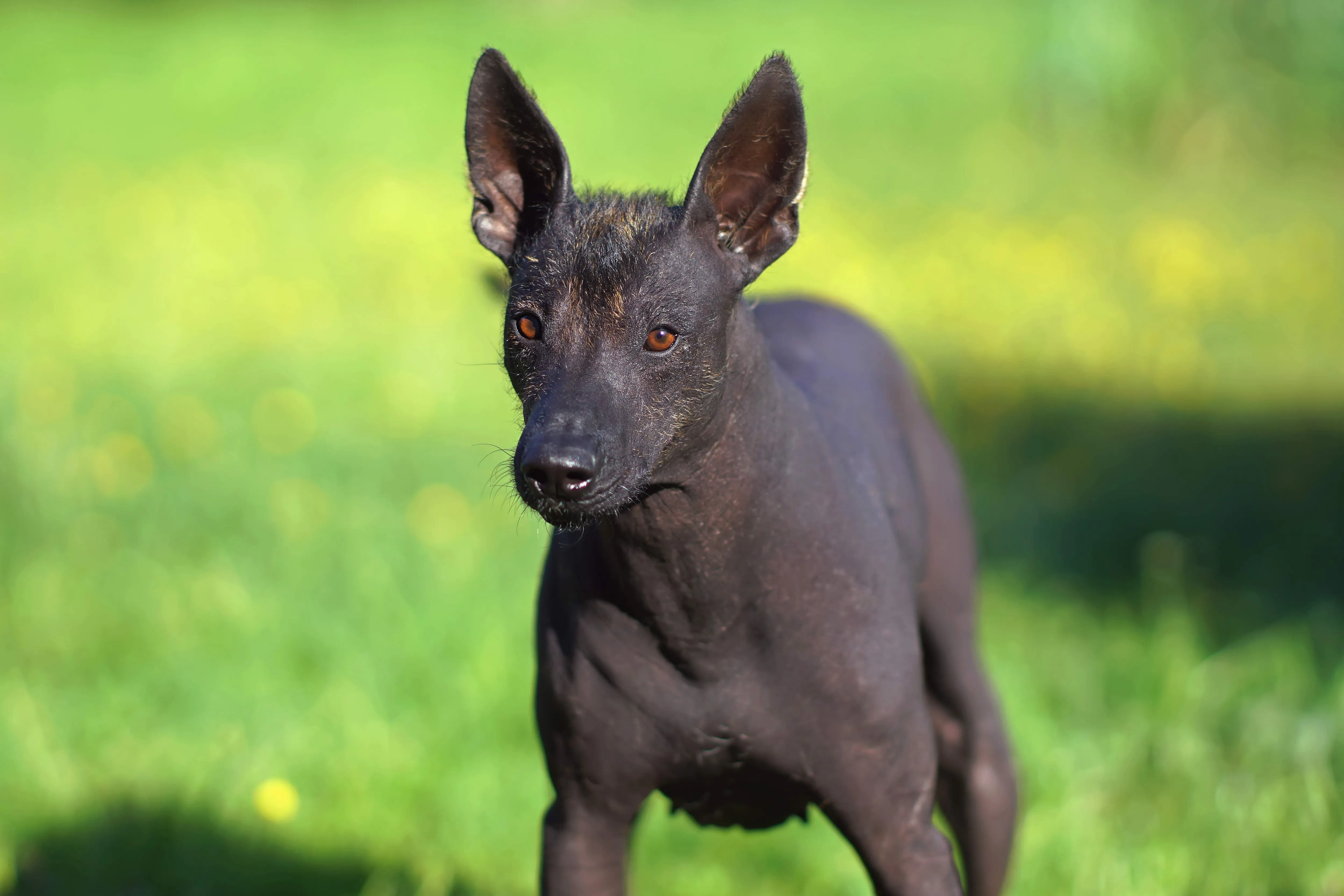 Black Mexican Hairless dog standing in grass
Black Mexican Hairless dog standing in grass
The Xoloitzcuintli, also known as the Mexican Hairless Dog, is an ancient and rare breed that comes in three sizes (toy, miniature, and standard). While primarily known for their hairless variety, some Xolos are born with a short, smooth coat. Both types are considered hypoallergenic due to the absence or minimal amount of hair. Hairless Xolos require specific skin care, including moisturizing and sun protection, while coated Xolos have very low grooming needs. They are calm, intelligent, and loyal companions, forming strong bonds with their families.
23. Whoodle
 Tan Whoodle puppy dragging a washcloth
Tan Whoodle puppy dragging a washcloth
A Whoodle is a cross between a Soft Coated Wheaten Terrier and a Poodle, resulting in a friendly, intelligent, and affectionate dog with a very low-shedding coat. Whoodles inherit the best traits from both parent breeds, making them playful yet gentle companions. Their soft, wavy to curly coats require regular brushing to prevent tangles and mats. They thrive on companionship and moderate exercise, making them suitable for various family dynamics.
24. Bernedoodle
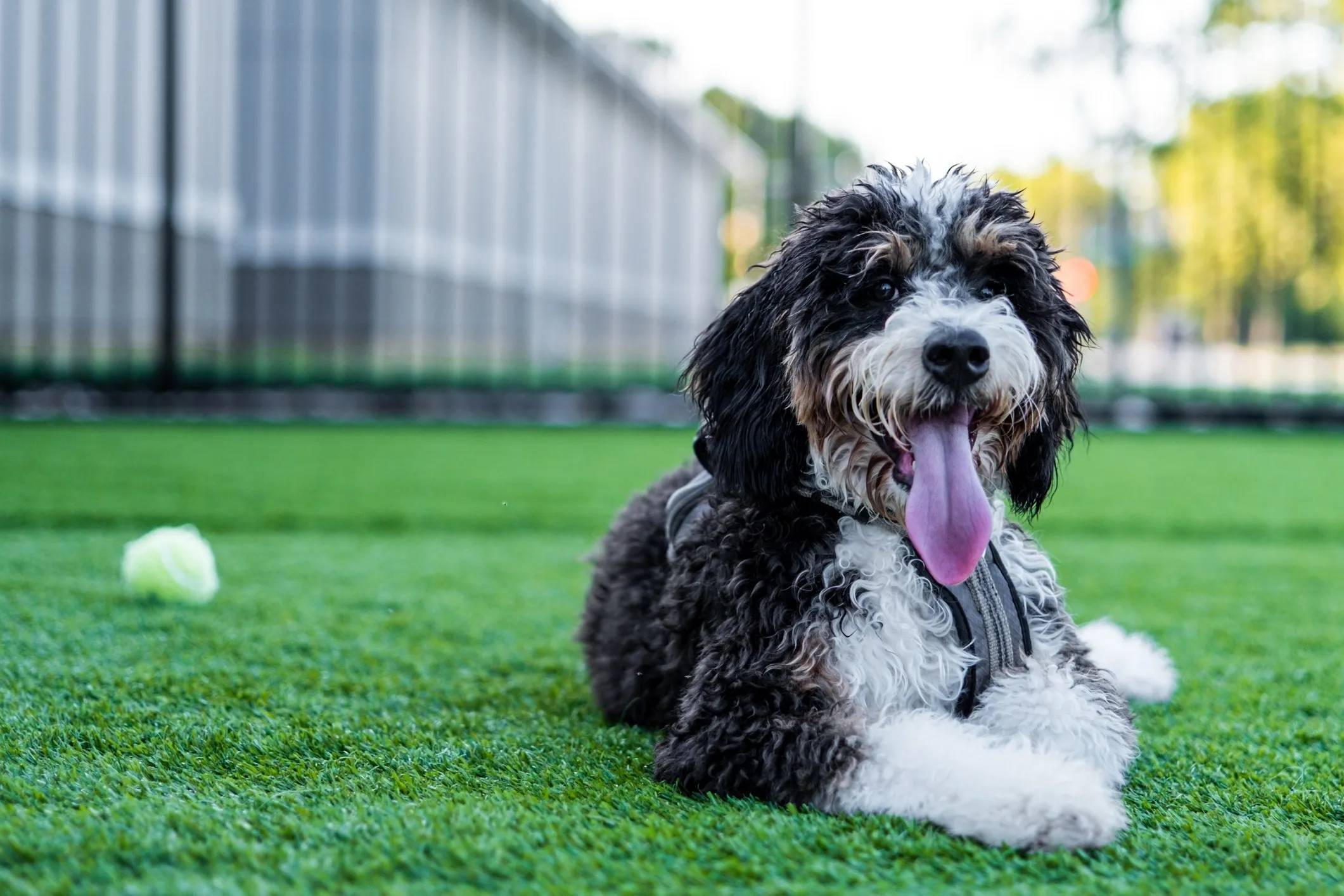 Large Bernedoodle dog lying in grass with his tongue out
Large Bernedoodle dog lying in grass with his tongue out
The Bernedoodle is a crossbreed of the Bernese Mountain Dog and the Poodle, combining the Poodle’s low-shedding coat with the Bernese’s gentle and friendly nature. These large hypoallergenic dogs are known for their affectionate demeanor, making them popular family pets, especially for households with children and other pets. Bernedoodles are intelligent and active, requiring ample exercise and mental stimulation to prevent boredom. Their coats can range from wavy to curly and need regular brushing to keep them mat-free.
25. Shorkie
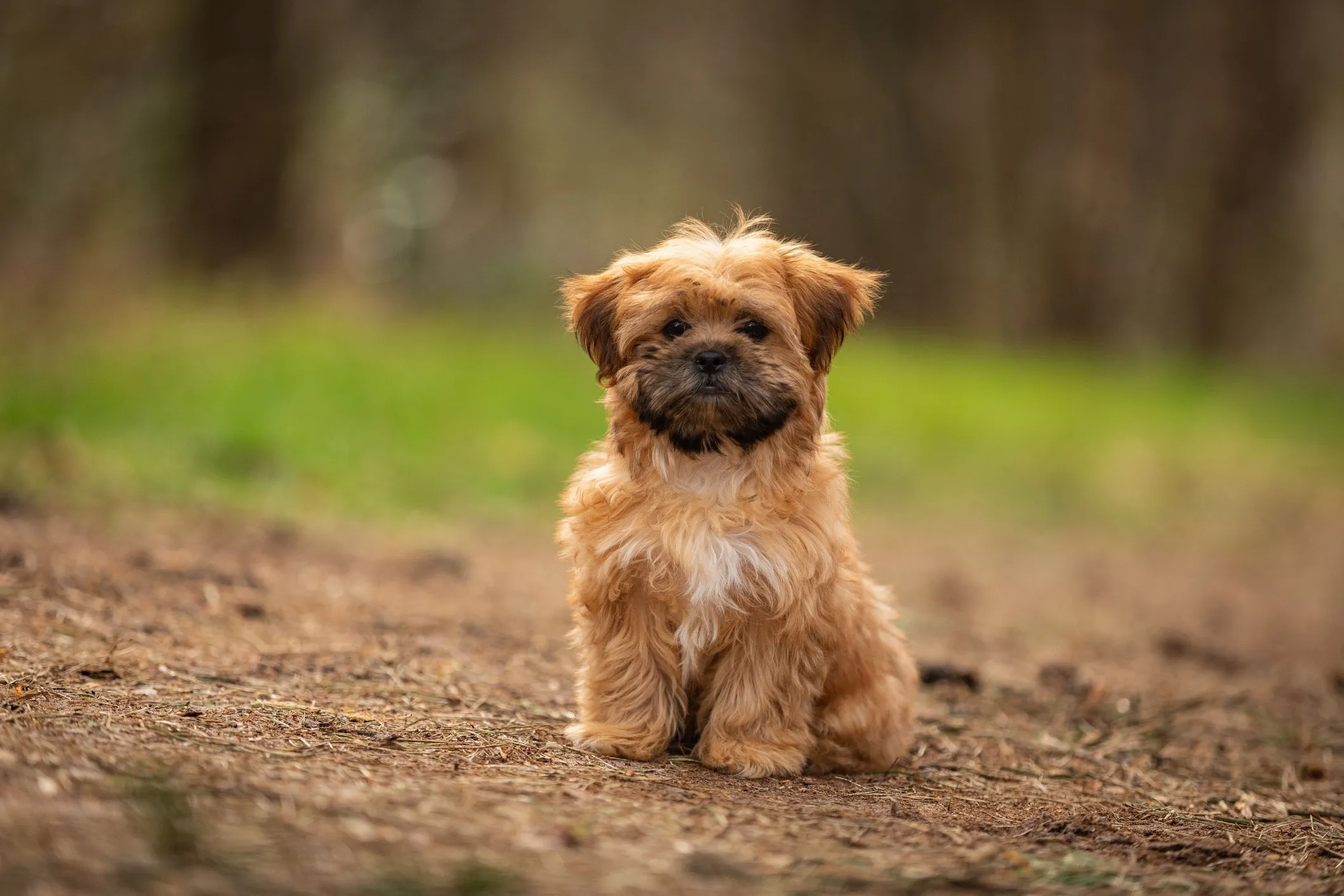 Tan and black Shih Tzu and Yorkie mix sitting on a hiking trail
Tan and black Shih Tzu and Yorkie mix sitting on a hiking trail
The Shorkie is a charming mixed breed, a cross between two low-shedding dogs: the Shih Tzu and the Yorkshire Terrier. This combination results in a small, playful, and friendly companion that embodies the best qualities of both parent breeds. Shorkies are affectionate lapdogs who thrive on human interaction. Like most dogs on this list, they require a dedicated and regular grooming routine to maintain their soft, flowing coats and prevent tangles.
26. Afghan Hound
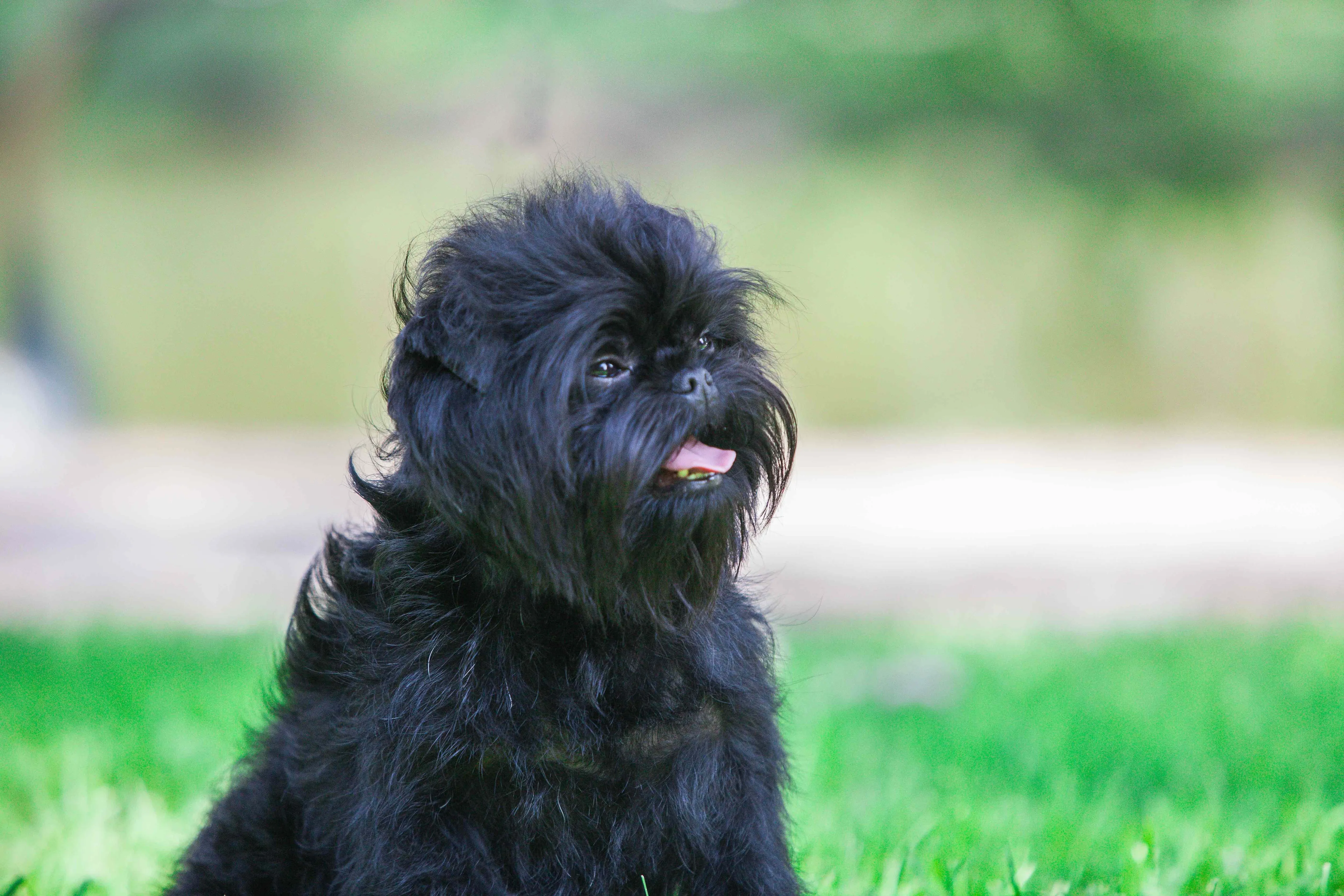 Gray and tan Afghan Hound looking at the camera
Gray and tan Afghan Hound looking at the camera
Afghan Hounds are striking dogs, renowned for their long, flowing coats and aristocratic appearance. Despite their abundant hair, they are considered low-shedding due to the fine texture of their single coat. These sighthounds are built for speed and endurance, requiring considerable exercise. They are loving with their families but can be aloof with strangers, making early and consistent socialization vital. Their magnificent coats demand extensive daily grooming to prevent mats and keep them in pristine condition.
27. Barbet
 Close-up of a curly red Barbet dog face
Close-up of a curly red Barbet dog face
The Barbet, pronounced “bar-bay,” is a cheerful and shaggy water dog from France. Their woolly, curly coat is low-shedding and provides excellent insulation, making them adept swimmers. Known for their characteristic “beard” (barbe in French), Barbets are intelligent, friendly, and eager to please. They make wonderful family pets for active homes that can provide plenty of exercise, especially water-based activities. Their dense coats require regular brushing (two to three times a week) with a slicker or pin brush to prevent matting, particularly after swimming.
28. Shih-Poo
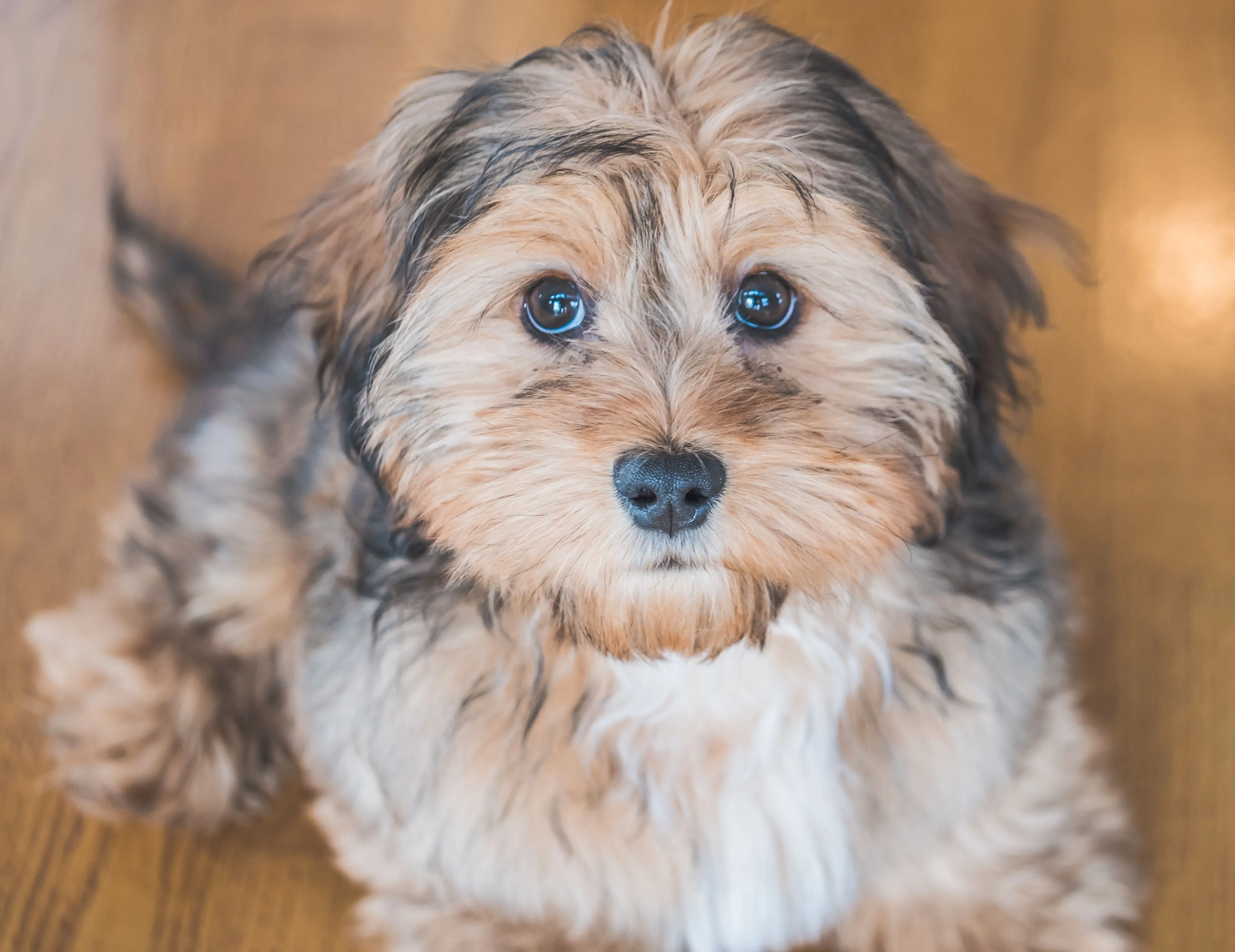 Tan and black Shih-Poo dog close-up
Tan and black Shih-Poo dog close-up
The Shih-Poo is a delightful mixed breed, typically a cross between a Shih Tzu and a Toy Poodle. This small pup inherits a low-shedding coat and a charming, playful personality from its parent breeds. Shih-Poos are adaptable and can thrive in almost any living situation, provided they receive about 30 minutes of daily exercise and regular brushing sessions. They are affectionate and enjoy being the center of attention, making them excellent companions for individuals or families looking for a loving lapdog.
29. Peruvian Inca Orchid
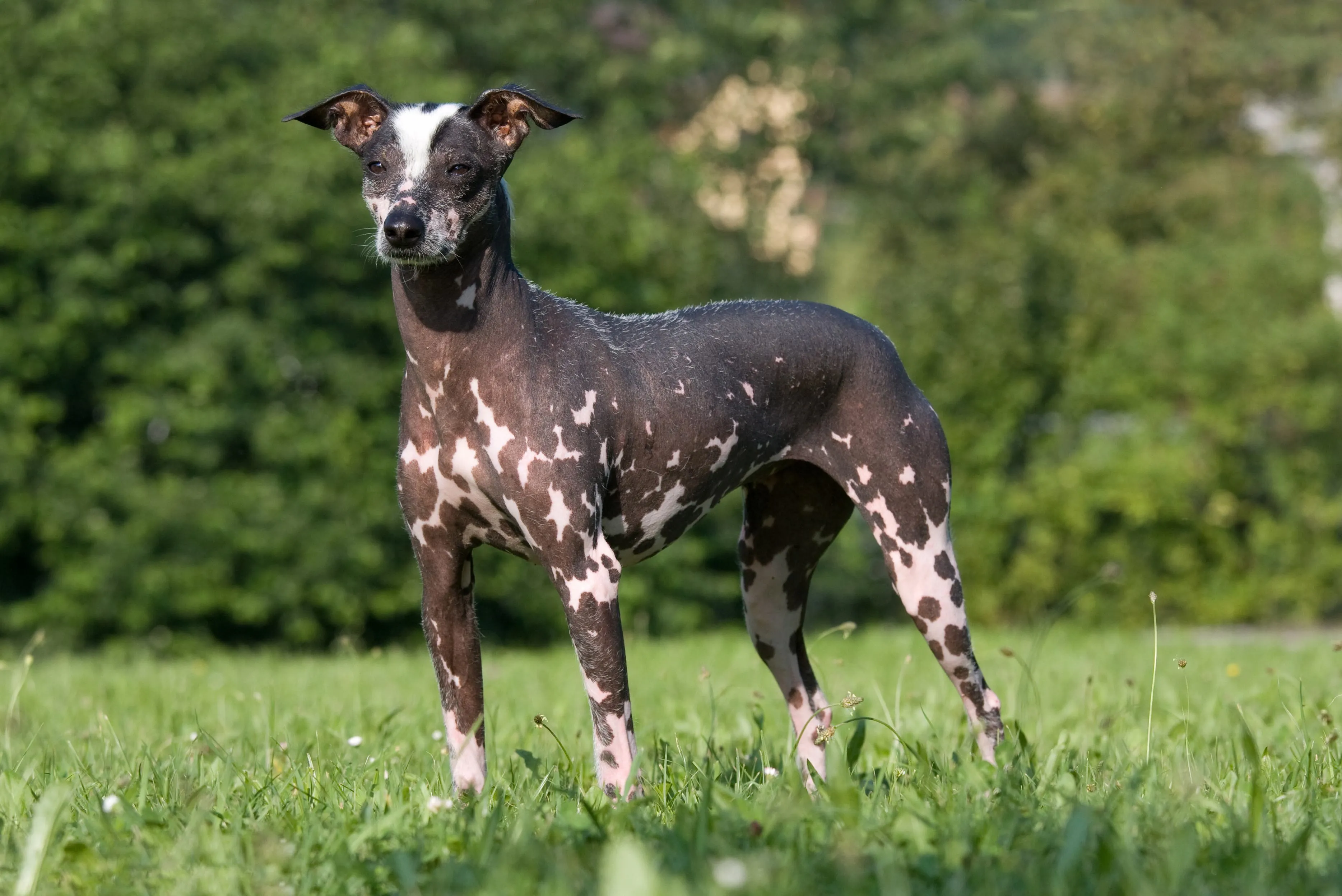 Peruvian Inca Orchid dog
Peruvian Inca Orchid dog
The Peruvian Inca Orchid is an ancient and somewhat rare breed, distinguished by its nearly hairless body, making it an ideal choice for allergy sufferers. The national dog of Peru, this breed comes in small, medium, and large sizes. While most are hairless, some individuals can have a short, single coat. They are elegant, agile, and protective, forming strong bonds with their families. Hairless Peruvian Inca Orchids require special skin care, including moisturizing and sun protection, due to their exposed skin.
30. Malshi
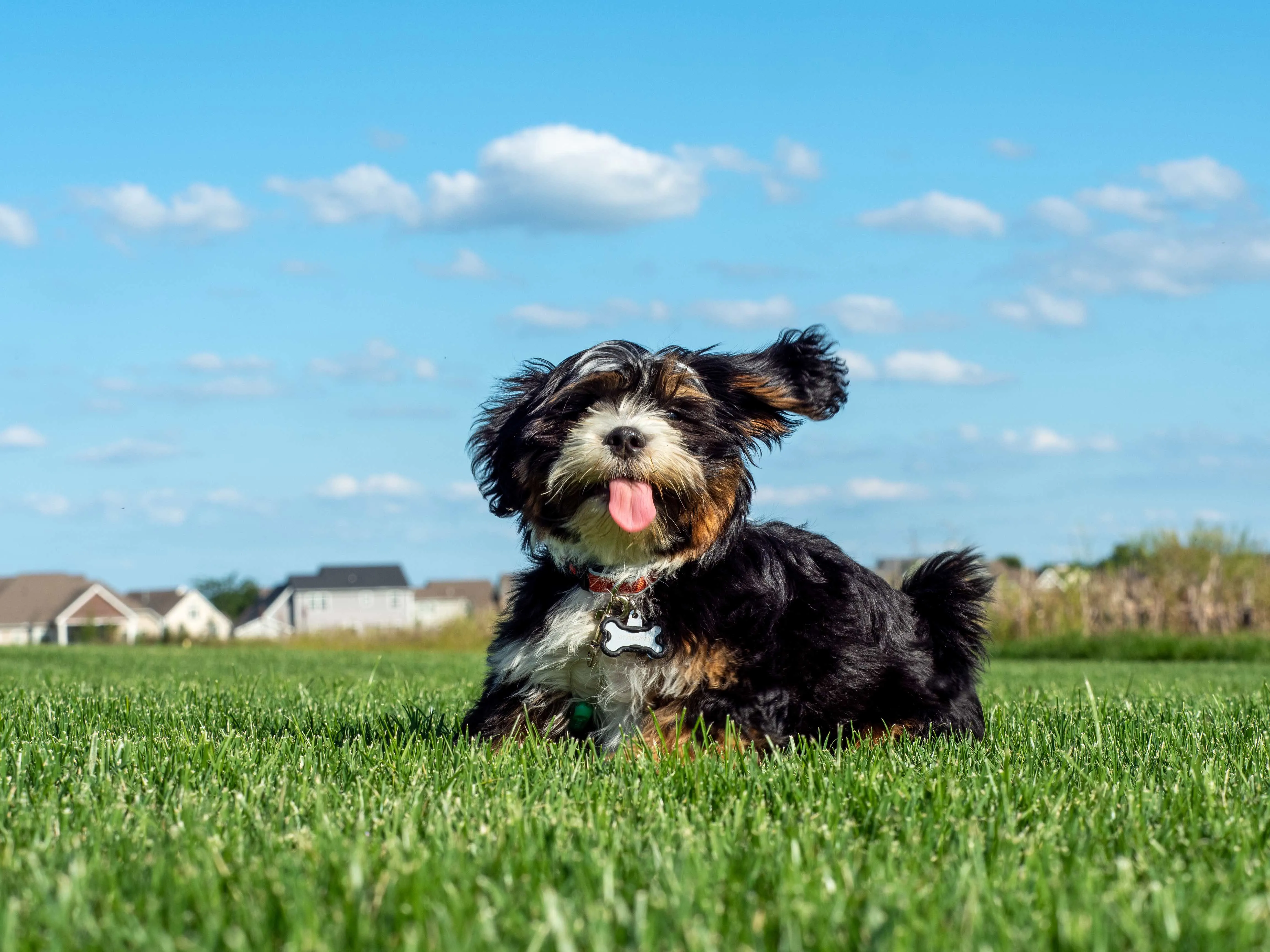 Tricolor Malshi dog in green grass
Tricolor Malshi dog in green grass
The Malshi is a popular crossbreed resulting from a Maltese and a Shih Tzu, combining the best traits of these two beloved low-shedding breeds. These small dogs are known for their happy, outgoing personalities and thrive on close companionship. Malshis are playful, affectionate, and generally adaptable to various living situations. Their soft, fluffy coats require consistent daily brushing and regular professional grooming to prevent tangles and mats, ensuring they look and feel their best.
Essential Tips for Living with a Low-Shedding Dog
Even with the best dog breeds that don’t shed, managing allergies requires proactive steps to minimize allergen exposure and ensure a harmonious home environment.
Keep Up With Grooming
Regular grooming is paramount for low-shedding breeds. Their coats, though non-shedding, still grow and can trap dander, dirt, and allergens close to the skin. This can also lead to painful matting if neglected. Ideally, these dogs should be brushed daily or every other day, and professionally groomed every 4 to 6 weeks. Regular bathing, typically every 4-6 weeks, with a specialized dog shampoo can help remove dander and keep the coat clean. For sensitive individuals, consider using dander-reducing products or having a non-allergic family member handle most of the grooming.
Maintain a Clean Home Environment
Minimizing allergens in your home goes beyond just grooming your dog. Regular cleaning helps reduce any accumulated pet dander. Vacuuming carpets and upholstery frequently with a HEPA filter vacuum cleaner, dusting surfaces, and washing bedding (both yours and your dog’s) weekly are crucial steps. Using air purifiers with HEPA filters can also help remove airborne allergens. Consider designating certain areas of your home as “allergen-free zones” where your dog is not allowed, such as bedrooms, to provide a sanctuary for allergy sufferers.
Consult Your Healthcare Provider
Managing dog allergies effectively often requires a multi-faceted approach. Before bringing a dog into your home, especially if you have known allergies, it’s advisable to consult with your doctor or an allergist. They can provide personalized advice, recommend allergy medications (antihistamines, nasal sprays), or discuss other treatment options like immunotherapy (allergy shots) which can help desensitize you to pet allergens over time. Avoiding direct contact with your dog’s saliva or urine, which also contain allergens, is also important. With careful planning and consistent management, living with a beloved canine companion, even with allergies, is entirely possible.
Bringing home one of the best dog breeds that doesn’t shed can truly enhance the lives of individuals with allergies, offering the immense joy and unconditional companionship of a dog without the constant struggle of allergic reactions. By understanding what “hypoallergenic” truly means and implementing proper care routines, you can create a loving and comfortable home for both you and your furry friend.
References
- American Kennel Club (AKC) – Breed information and care guides.
- Veterinary medical journals and publications on pet allergies and dermatology.
- National Institute of Environmental Health Sciences (NIEHS) – Information on allergens and pet dander.
- Professional veterinary resources and certified animal health technicians.
